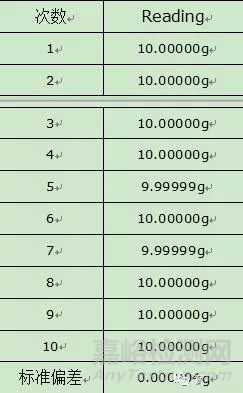您当前的位置:检测资讯 > 科研开发
嘉峪检测网 2019-06-24 14:47
USP规定的“准确称定”是用来衡量天平的,而不是ChP规定的称量数值的保留位数决定的。亲爱的小伙伴,不用再为USP41规定的最小准确称量值的确定方法烦恼了,也没必要花几千块钱委托天平厂家做,下面的USP40<41>BALANCES解析并配有实例讲解,包您一看就会。
背景
This chapter states the requirements for balances used for materials that must be accurately weighed (see General Notices and Requirements, 8.20). Unless otherwise specified, when substances must be “accurately weighed,” the weighing shall be performed using a balance that is calibrated over the operating range and meets the requirements defined for repeatability and accuracy. For balances used for other applications, the balance repeatability and accuracy should be commensurate with therequirements for its use.
本章节的要求适用于必须“准确称量”样品的天平要求(见通用条款和要求,8.20),除非另有规定,否则当被要求准确称量时,必须使用称量范围经校正且符合重复性及准确性要求的天平。其他使用目的的天平,重复性及准确性必须与其使用要求相适应。
For a discussion of the theoretical basis of these requirements, see Weighing on an Analytical Balance 〈1251〉, which may be a helpful—but not mandatory—resource.
这些要求的理论基础的讨论详见<1251分析天平的称量>章节,该章节不是强制性要求。
Repeatability重复性
Repeatability is assessed by weighing one test weight NLT 10 times. [Note—The test weight must be within the balance's operating range, but the weight need not be calibrated. Because the standard deviation is virtually independent of sample mass within the balance's capacity, use of a small test weight, which may be difficult to handle, is not required.]
重复性是通过称取一个测试砝码不少于10次(备注:该测试砝码必须在天平的称量范围内,但该砝码可不需校正,因为这标准偏差实际上是独立于样品的质量而存在于天平,使用小重量测试砝码将更难达到,不做要求。)
Repeatability is satisfactory if two times the standard deviation of the weighed value, divided by the desired smallest net weight (i.e., smallest net weight that the users plan to use on that balance), does not exceed 0.10%. If the standard deviation obtained is less than 0.41d, where d is the scale interval, replace this standard deviation with 0.41d. In this case, repeatability is satisfactory if 2 × 0.41d, divided by the desired smallest net weight, does not exceed 0.10%.
如果两倍的称量值的标准偏差(S)除以期望的最小准确净重不超过0.10%,则重复性被认为是符合要求的。(最小准确净重m:是使用者计划在该天平上称取的最小重量)。
如果计算的标准偏差小于0.41d,这里的d为显示增量,用0.41d来代替测得的标准偏差,这种情况下,如果两倍的0.41d除以想要设定的最小准确净重不超过0.10%,则重复性被认为是符合要求的。
实例分析:因为使用小重量测试砝码,重现性将更难达到,故选用小砝码,例如10 g砝码,连续测定10次,结果分别为
该台天平的d为0.01mg,0.41d为0.0000041g,故标准偏差大于0.41d,故将S=0.000004g带入计算
故最小准确净重m=2000×0.000004g=0.00843g。
由于进行上述测试时,一般情况下,实验室处于最佳条件状态,真实的称量条件下,可能达不到上述条件,故应乘以相应的系数,建议1.5~2的系数来制定天平最终的最小准确净值。
Accuracy准确度
The accuracy of a balance is satisfactory if its weighing value, when tested with a suitable weight(s), is within 0.10% of the test weight value.
当使用一个或数个合适的砝码进行测试时,称量结果在测试值的0.10%的允许范围内,则表明该天平符合准确性的要求。
A test weight is suitable if it has a mass between 5% and 100% of the balance's capacity. The test weight's maximum permissible error (mpe), or alternatively its calibration uncertainty, shall be NMT one-third of the applied test limit of the accuracy test. [Note—Applicable standards are the following: ASTM E617 (available fromhttp://www.astm.org) and OIML R 111 (available from http://www.oiml.org).]
测试砝码的要求:测试砝码应处于天平量程范围的5%~100%的范围内是合适的,测试砝码的最大允许误差(mpe)或者校正不确定度应该不超过准确性测试限值的三分之一。
实例分析:砝码应处于天平量程范围的5%~100%的范围内,且测试砝码的最大允许误差(mpe)或者校正不确定度应该不超过准确性测试值的三分之一,故应选用大砝码,例如选用200g砝码具体数值如下表:
选用砝码
校正值
显示
偏差
允许范围
200g
200.00005g
200.00003g
0.00002g
0.20000g




故称量结果在测试值的0.10%的允许范围内。
来源:锦心绣口、药事纵横


